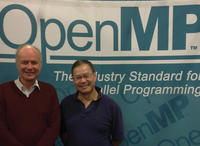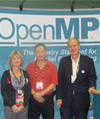
Exploring the New OpenMP Specification
The OpenMP consortium is the collection of companies and organizations behind the OpenMP standard, which the group calls "the de-facto standard for parallel programming on shared memory systems." Many scientists and high-performance computing specialists are familiar with OpenMP as a standard for building efficient and easily scalable HPC applications, and a new generation of enterprise programmers is starting to become familiar with OpenMP through the recent popularity of parallel programming and big data techniques. Last year, we talked to OpenMP CEO Michael Wong and Marketing Coordinator Matthijs van Waveren on plans for OpenMP and the path ahead [1].
A year later, OpenMP has added many new consortium members and has rolled out a draft of the new OpenMP 4.0 specification, which, according to the project, promises "significant enhancements to parallelism." We checked in with Wong and van Waveren at the recent SC12 supercomputing conference in Salt Lake City, Utah, USA, for an update on the new OpenMP 4.0 specification.
Joe Casad, ADMIN Magazine: How has the year gone for OpenMP?
Michael Wong: We've had a fantastic year. Mind you, we've been working hard to bring forward a new release to OpenMP called 4.0, with significant new leaps forward for intensive parallelism, and just as important as that, we also released a new technical report, one on accelerators, that will help us compete in this exciting market, with all the different GPUs and digital signal processors. And this is something that the marketplace has been looking forward to for a number of years: a high-level language way of doing accelerator programming without having to shift down into lower level code or some proprietary language. Everyone has been looking for this, and we finally have been able to come together after three
...Buy ADMIN Magazine
Subscribe to our ADMIN Newsletters
Subscribe to our Linux Newsletters
Find Linux and Open Source Jobs
Most Popular
Support Our Work
ADMIN content is made possible with support from readers like you. Please consider contributing when you've found an article to be beneficial.






